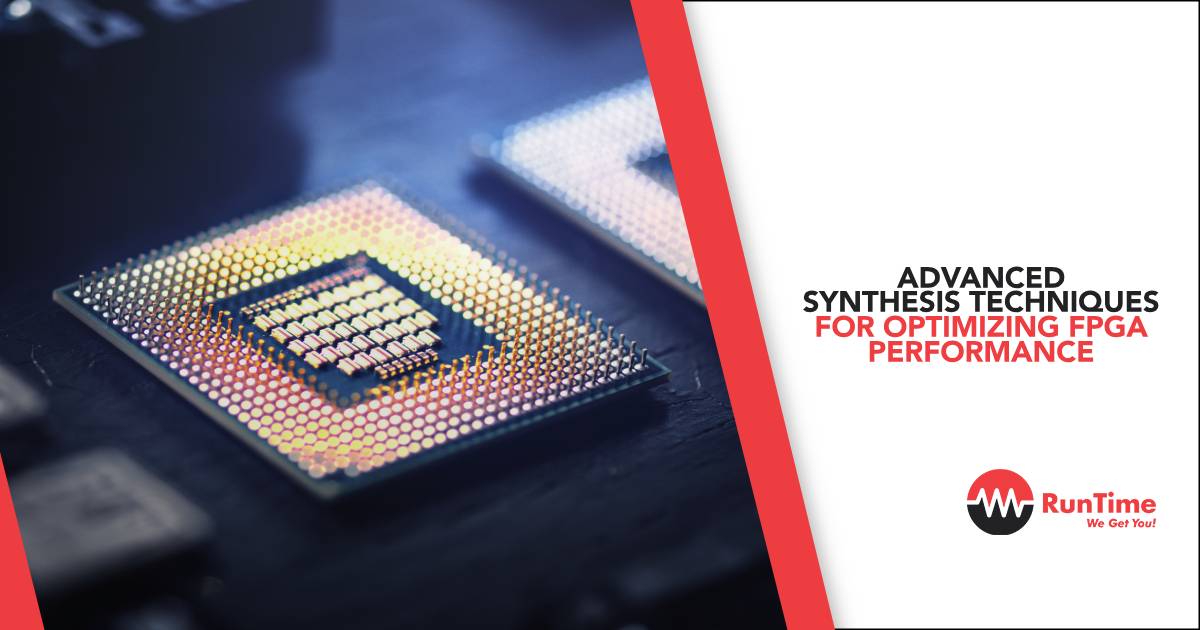Field-Programmable Gate Arrays (FPGAs) have become the go-to hardware platform for applications requiring high performance, low latency, and unparalleled flexibility. Whether you’re designing for high-speed data processing, signal filtering, or AI inference at the edge, optimizing FPGA performance is critical to meeting your application’s requirements.
The synthesis process lies at the heart of FPGA design, transforming your high-level hardware description into an optimized implementation on the FPGA fabric. However, efficient synthesis is no small feat—it requires a deep understanding of FPGA architecture, design trade-offs, and advanced optimization techniques.
In this article, we’ll dive into advanced synthesis techniques that embedded engineers can leverage to maximize the performance of their FPGA designs. We’ll cover everything from resource optimization and pipelining to timing analysis and clock domain management. By the end of this guide, you’ll have actionable insights to make your FPGA designs faster, more resource-efficient, and highly reliable.
Understanding FPGA Synthesis
FPGA synthesis is the process of converting your high-level HDL (Hardware Description Language) code—written in VHDL, Verilog, or SystemVerilog—into a netlist of logic gates and flip-flops that are mapped to the FPGA fabric. This is followed by implementation steps such as placement, routing, and bitstream generation.
Synthesis Challenges
- Resource Constraints: Limited lookup tables (LUTs), flip-flops, block RAM (BRAM), and DSP slices.
- Timing Constraints: Meeting timing requirements such as clock frequencies and setup/hold times.
- Power Efficiency: Optimizing designs for low power consumption in resource-constrained applications.
- Tool Limitations: Understanding and working around the behavior of synthesis tools like Xilinx Vivado or Intel Quartus Prime.
Synthesis is where your design begins to take physical form, so optimizing this process can significantly impact your final implementation.
1. Start with Efficient RTL Coding Practices
Optimizing FPGA performance begins at the Register Transfer Level (RTL), where your design is first described.
Best Practices for RTL Coding
- Avoid Overly Complex Combinational Logic:
- Large combinational blocks can increase propagation delay and make meeting timing constraints difficult.
- Split complex logic into smaller stages with registers in between.
- Use Resource Sharing:
- Reuse hardware resources like multipliers or adders for multiple operations to save DSP slices.
- Example: Time-multiplex a single multiplier across several computational tasks.
- Avoid Latches:
- Latches are harder to control in synthesis and routing. Always use edge-triggered flip-flops for state storage.
- Explicitly Define Reset Conditions:
- Make sure all registers have defined reset values to ensure predictable behavior after power-up.
- Use Parameters/Generics:
- Make your design parameterizable to adapt it easily to different configurations or resource constraints.
2. Leverage Pipelining for Higher Throughput
Pipelining is one of the most effective techniques for improving FPGA performance, especially in high-speed designs.
What is Pipelining?
Pipelining involves breaking a long combinational logic path into smaller stages separated by flip-flops. This reduces the critical path delay, allowing the design to operate at a higher clock frequency.
Benefits of Pipelining
- Higher Clock Speeds: Reduces propagation delay per stage, enabling faster operation.
- Improved Throughput: Allows multiple operations to be processed simultaneously at different stages of the pipeline.
Implementation Tips
- Identify critical paths in your design using timing analysis tools and insert pipeline registers at appropriate points.
- Balance the pipeline stages to ensure even distribution of delay across the pipeline.
- Be cautious of pipeline latency; ensure your application can tolerate the added cycles.
3. Optimize Resource Utilization
FPGAs provide a mix of LUTs, flip-flops, DSP blocks, and BRAM. Efficiently utilizing these resources is key to achieving optimal performance.
Tips for Resource Optimization
- Pack Logic into LUTs:
- Combine logic operations to fully utilize LUTs. Modern FPGAs can implement multiple small functions in a single LUT.
- Use the RESOURCE_SHARING or LOGIC_OPTIMIZATION synthesis directives if supported by your tool.
- Efficient Memory Usage:
- Use BRAM for large data storage instead of distributed RAM, which consumes LUTs.
- Map arrays and FIFOs explicitly to BRAM in your RTL code.
- Leverage DSP Blocks:
- Map arithmetic operations like multiplications and MAC (Multiply-Accumulate) directly to DSP slices.
- Check synthesis reports to ensure DSP blocks are being utilized instead of LUT-based logic.
- Minimize Unused Logic:
- Remove unused signals or modules during synthesis to save resources and reduce power consumption.
4. Understand and Manage Timing Constraints
Meeting timing constraints is crucial for ensuring your design functions correctly at the desired clock frequency.
Key Timing Concepts
- Critical Path: The longest delay path in your design, which determines the maximum clock frequency.
- Setup Time: The minimum time before the clock edge that a signal must be stable.
- Hold Time: The minimum time after the clock edge that a signal must remain stable.
Techniques for Meeting Timing
- Use Timing Reports:
- Analyze post-synthesis timing reports to identify critical paths.
- Focus on optimizing the longest paths first.
- Clock Balancing:
- Minimize skew by ensuring clock paths are routed uniformly.
- Retiming:
- Allow synthesis tools to automatically move flip-flops across logic gates to optimize timing.
- Clock Domain Crossing:
- Use proper synchronization techniques like dual flip-flop synchronizers for signals crossing clock domains.
5. Optimize Clock Domains and Clocking Resources
FPGAs often use multiple clock domains, making clock management a critical aspect of design.
Clock Domain Techniques
- Minimize Clock Domains:
- Reduce the number of clock domains if possible to simplify timing and routing.
- Use PLLs/DLLs:
- Use phase-locked loops (PLLs) or delay-locked loops (DLLs) to generate multiple clocks with precise phase and frequency relationships.
- Asynchronous Clock Crossing:
- Use FIFO-based designs for transferring data between asynchronous clock domains.
6. Explore Parallelism
Parallelism is one of the core strengths of FPGAs. Unlike CPUs, which execute instructions sequentially, FPGAs can perform multiple operations simultaneously.
How to Leverage Parallelism
- Replicate Critical Modules:
- For high-throughput applications, replicate processing units to handle multiple tasks in parallel.
- Unroll Loops:
- Use loop unrolling in your HDL code to parallelize operations.
7. Use Advanced Synthesis Techniques
Modern synthesis tools offer several advanced options to optimize performance.
Useful Synthesis Features
- High-Level Synthesis (HLS):
- Convert C/C++ code directly into HDL. HLS tools automatically optimize parallelism, pipelining, and resource utilization.
- Example: Use Xilinx Vitis HLS or Intel HLS Compiler.
- Synthesis Constraints:
- Apply constraints like MAXDELAY, MULTICYCLE_PATH, or KEEP to guide the synthesis tool.
- Example: Use constraints to prioritize certain signals or logic paths.
- IP Cores:
- Use optimized Intellectual Property (IP) cores for complex tasks like FFTs, Ethernet MACs, or DDR controllers.
- Resource Sharing:
- Use synthesis tools to automatically share resources like adders and multipliers across operations.
8. Perform Post-Synthesis Optimization
Post-synthesis steps like placement, routing, and floorplanning can significantly affect performance.
Tips for Post-Synthesis Optimization
- Floorplanning:
- Assign critical modules to specific FPGA regions to minimize routing delays.
- Analyze Placement and Routing Reports:
- Identify and address long routes that could introduce timing issues.
- Use Incremental Compilation:
- Recompile only the modified portions of your design to save time and maintain stability.
9. Validate with Thorough Testing
Optimization is only meaningful if your design works as intended. Validate your design with rigorous testing.
Testing Tips
- Use simulation to verify functional correctness before synthesis.
- Perform hardware-in-the-loop (HIL) testing to validate timing and resource usage on actual FPGA hardware.
- Run corner-case tests for various clock frequencies and input conditions.
Case Study: Optimizing an FPGA for Real-Time Signal Processing
Scenario: A real-time signal processing application required an FPGA design to process data at 200 MHz, but initial synthesis failed to meet timing constraints.
Optimization Steps:
- Pipelining: Critical data paths were split into smaller stages, reducing the critical path delay.
- Resource Mapping: Multiplications were explicitly mapped to DSP slices to reduce LUT usage.
- Clock Optimization: A PLL was used to generate a stable 200 MHz clock, and clock balancing minimized skew.
- Timing Analysis: Post-synthesis timing reports were used to adjust placement and improve routing efficiency.
Outcome: The optimized design met timing constraints and operated reliably at 200 MHz.
Conclusion
Optimizing FPGA performance is both an art and a science. By combining advanced synthesis techniques with a strong understanding of FPGA architecture, embedded engineers can create designs that are not only functional but also efficient and scalable. From efficient RTL coding and pipelining to clock domain management and post-synthesis optimization, each step in the design process offers opportunities for improvement.
As FPGAs continue to drive innovation in industries like AI, telecommunications, and industrial automation, mastering these techniques will enable you to harness the full potential of this powerful technology.









